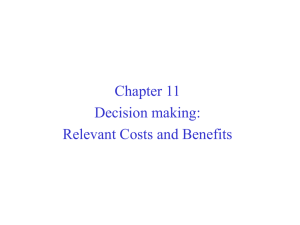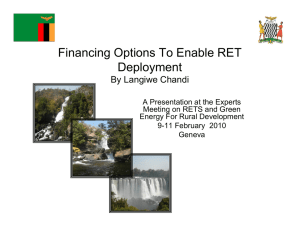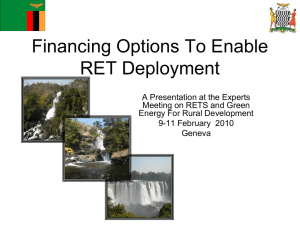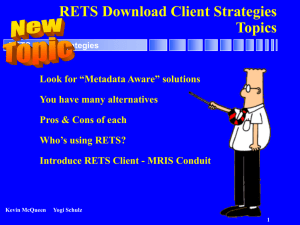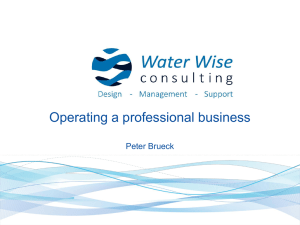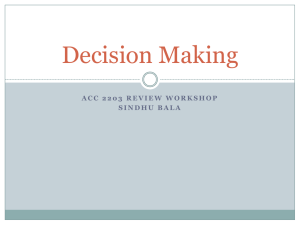Chapter 11 - Fisher College of Business
advertisement
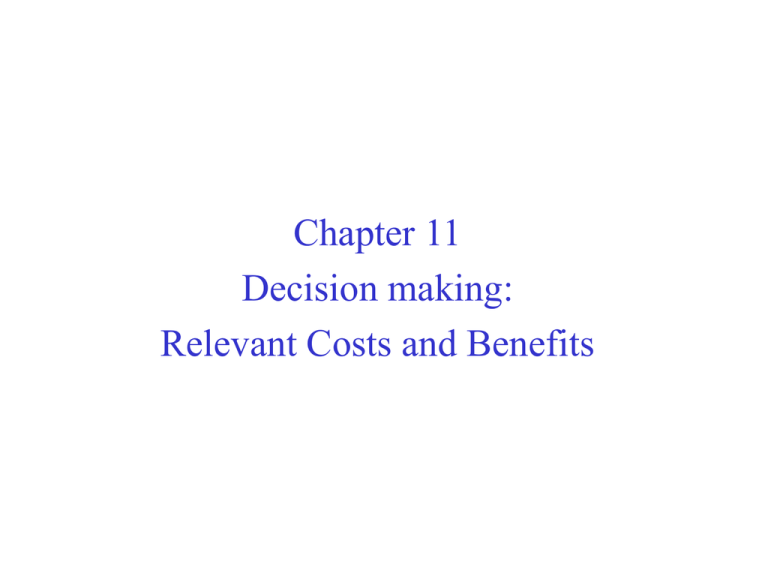
Chapter 11 Decision making: Relevant Costs and Benefits DIFFERENTIAL COSTS AND REVENUES Bill is currently employed as a lifeguard, but he has been offered a job in an auto service center in the same town. The differential revenues and costs between the two jobs are listed below: Lifeguard Monthly salary Auto Service Center Differential costs and revenues $1,200 $1,500 $300 30 90 60 Meals 150 150 0 Apartment rent 450 450 0 0 50 50 10 0 640 740 100 $ 560 $ 760 $200 Monthly expenses: Commuting Uniform rental Union dues Total monthly expenses Net monthly income (10) Identifying Relevant Costs Automobile Costs (based on 10,000 miles driven per year) 1 2 3 4 5 6 Annual straight-line depreciation on car Cost of gasoline Annual cost of auto insurance and license Maintenance and repairs Parking fees at school Total average cost 7 8 9 10 11 12 13 Annual Cost of Fixed Items $ 2,800 1,380 360 Cost per Mile $ 0.280 0.050 0.138 0.065 0.036 $ 0.569 Some Additional Information Reduction in resale value of car per mile of wear Round-trip train fare Cost of hotel in New York Cost of putting dog in kennel while gone Benefit of having car in New York Hassle of parking car in New York Per day cost of parking car in New York $ 0.026 $ 104 $ 200 $ 40 ???? ???? $ 25 Total and Differential Cost Approaches The management of a company is considering a new laborsaving machine that rents for $3,000 per year. Data about the company’s annual sales and costs with and without the new machine are: Sales (5,000 units @ $40 per unit) Less variable expenses: Direct materials (5,000 units @ $14 per unit) Direct labor (5,000 units @ $8 and $5 per unit) Variable overhead (5,000 units @ $2 per unit) Total variable expenses Contribution margin Less fixed expense: Other Rent on new machine Total fixed expenses Net operating income Current Situation $ 200,000 Situation With New Machine $ 200,000 Differential Costs and Benefits - 70,000 40,000 10,000 120,000 80,000 70,000 25,000 10,000 105,000 95,000 15,000 15,000 62,000 62,000 18,000 62,000 3,000 65,000 30,000 (3,000) (3,000) 12,000 $ $ Analysis of Special Decisions Let’s take a look at another decision faced by many businesses. We need a particular component for our manufacturing process. Do you think we should make or buy this particular item? W Make or Buy Han Products manufactures 30,000 units of part S-6 each year for use on its production line. At this level of activity, the cost per unit for part S-6 is as follows: Direct materials Direct labor Variable manufacturing overhead Fixed manufacturing overhead Total cost per part $3.60 10.00 2.40 9.00 $25.00 Make or Buy (continued) An outside supplier has offered to sell 30,000 units of part S-6 each year to Han Products for $21 per part. If Han Products accepts this offer, the facilities now being used to manufacture part S-6 could be rented to another company at an annual rental of $80,000. However, Han Products has determined that two-thirds of the fixed manufacturing overhead being applied to part S-6 would continue even if part S-6 were purchased from the outside supplier. Prepare computations showing how much profits will increase or decrease if the outside supplier’s offer is accepted. Analysis of Special Pricing Decisions Let’s take a look at another decision faced by many businesses: Another firm has offered to pay us $10 for a product that normally sells for $25. Do you think we should accept this special order? W Accept/Reject Special Orders Polaski Company manufactures and sells a single product called a Ret. Operating at capacity, the company can produce and sell 30,000 Rets per year. Costs associated with this level of production and sales are given below: Unit Total Direct materials $15 $450,000 Direct labor 8 240,000 Variable manufacturing overhead 3 90,000 Fixed manufacturing overhead 9 270,000 Variable selling expense 4 120,000 Fixed selling expense 6 180,000 Total cost $45 $1,350,000 The Rets normally sell for $50 each. Fixed manufacturing overhead is constant at $270,000 per year within the range of 25,000 through 30,000 Rets per year. Accept/Reject Special Orders (continued) Assume that due to a recession, Polaski Company expects to sell only 25,000 Rets through regular channels next year. A large retail chain has offered to purchase 5,000 Rets if Polaski is willing to accept a 16% discount off the regular price. There would be no sales commissions on this order; thus, variable selling expenses would be slashed by 75%. However, Polaski Company would have to purchase a special machine to engrave the retail chain’s name on the 5,000 units. This machine would cost $10,000. Polaski Company has no assurance that the retail chain will purchase additional units in the future. Determine the impact on profits next year if this special order is accepted. Accept/Reject Special Orders (continued) Refer to the original data. Assume again that Polaski Company expects to sell only 25,000 Rets through regular channels next year. The U.S. Army would like to make a one-time-only purchase of 5,000 Rets. The Army would pay a fixed fee of $1.80 per Ret, and it would reimburse Polaski Company for all costs of production (variable and fixed) associated with the units. Because the army would pick up the Rets with its own trucks, there would be no variable selling expenses associated with this order. If Polaski Company accepts the order, by how much will profits increase or decrease for the year? Accept/Reject Special Orders (continued) Assume the same situation as that described in the previous slide, except that the company expects to sell 30,000 Rets through the regular channels next year. Thus, accepting the U.S. Army’s order would require giving up regular sales of 5,000 Rets. If the Army’s order is accepted, by how much will profits increase or decrease from what they would be if the 5,000 Rets were sold through regular channels? Carrying Costs of Inventory Annual estimated stereo CD player requirements for next year 1,000,000 units Cost per unit when each purchase is equal to 10,000 units $16.00 Cost per unit when each purchase is equal to or greater than 500,000 units; $16 minus 1% discount $15.84 Cost of a purchase order $500 Alternatives under consideration: A. Make 100 purchases of 10,000 units each during next year B. Make 2 purchases of 500,000 units during the year Average investment in inventory: A. (10,000 units x $16.00 per unit) / 2 a B. (500,000 units x $15.84 per unit / 2 a Annual rate of return if cash is invested elsewhere (for example, bonds or stocks at the same level of risk as investment in inventory) $80,000 $3,960,000 9% a The example assumes that stereo-CD-player purchases will be used uniformly throughout the year. The average investment in inventory during the year is the cost of the inventory when a purchase is received plus the cost of inventory just before the next purchase is delivered (in our example, zero) divided by 2. Soho will pay cash for the stereo CD players it buys. Which purchasing alternative is more economical for Soho? Scarce Resource Constraint A company has two products: a plain cellular phone and a fancier cellular phone with many special features: Selling price Variable costs Contribution margin Contribution-margin ratio Plain Phone $ 80 64 $ 16 20% Fancy Phone $ 120 84 $ 36 30% Scarce Resource Constraint Which product is more profitable? On which should the firm spend its resources? It depends. If sales are restricted by demand for only a limited number of phones, fancy phones are more profitable. Scarce Resource Constraint Suppose annual demand for phones of both types is more than the company can produce in the next year. Only 10,000 hours of capacity are available If in one hour plant workers can make either three plain phones or one fancy phone, which phone is more profitable? Scarce Resource Constraint 1. Units per hour 2. Contribution margin per unit Contribution margin per hour Total contribution for 10,000 hours Plain Phone 3 $ 16 Fancy Phone 1 $ 36 Another Scarce Resource Decision Power Recreation assembles two engines - a snowmobile engine and a boat engine - at its Lexington, Kentucky, plant. Selling Price Variable cost per unit Contribution margin per unit Contribution margin percentage ($240/$800; $375/$1,000) Snowmobile Boat Engine Engine $800 $1,000 560 625 $240 $375 30% 37.5% Scarce Resource Decision (cont.) Assume that only 600 machine-hours are available daily for assembling engines. Additional capacity cannot be obtained in the short run. Power Recreation can sell as many engines as it produces. The constraining resource, then, is machine-hours. It takes two machine-hours to produce one snowmobile engine and five machine-hours to produce one boat engine. What product mix should Power Recreation choose to maximize its operating income? Analysis of Equipment Replacement Decisions Let’s take a look at another decision faced by many businesses: Should we replace a machine with a newer and more efficient one? W Equipment Replacement Decision A manager at White Co. wants to replace an old machine with a new, more efficient machine: NNeeww m maacchhiinnee:: LLiisstt ppririccee AAnnnnuuaall vvaarria iabble le eexxppeennsseess EExxppeecctteedd life life in in yyeeaarrss OOld ld m maacchhin inee:: OOrrig igin inaall ccoosstt RReem maain inin ingg bbooookk vvaalu luee DDis isppoossaall vvaalu luee nnooww AAnnnnuuaall vvaarria iabble le eexxppeennsseess RReem maain inin ingg lilife fe in in yyeeaars rs $$ 9900,,000000 8800,,000000 55 $$ 7722,,000000 6600,,000000 1155,,000000 110000,,000000 55 Equipment Replacement Decision White’s sales are $200,000 per year Fixed expenses, other than depreciation, are $70,000 per year Should the manager purchase the new machine? Another Equipment Replacement Decision Toledo Company is considering replacing a metal-cutting machine with a newer model. The new machine is more efficient than the old machine, but it has a shorter life. Revenues from aircraft parts ($1.1 million per year) will be unaffected by the replacement decision. Here’s the data on the existing (old) machine and the replacement (new) machine: Equipment Replacement Decision (cont.) Old Machine Original Cost New Machine $1,000,000 $600,000 Useful Life 5 years 2 years Current age 3 years 0 years Remaining useful life 2 years 2 years Accumulated Depreciation $600,000 Not acquired yet Book Value $400,000 Not acquired yet Current disposal value (in cash) Terminal disposal value (in cash 2 years from now) Annual operating costs (maintenance, energy, repairs, coolants, and so on) $40,000 Not acquired yet $0 $0 $800,000 $460,000 Equipment Replacement Decision (cont.) Toledo Corporation uses straight-line depreciation. To focus on relevance, we ignore time value of money and income taxes. Should Toledo replace its old machine?


